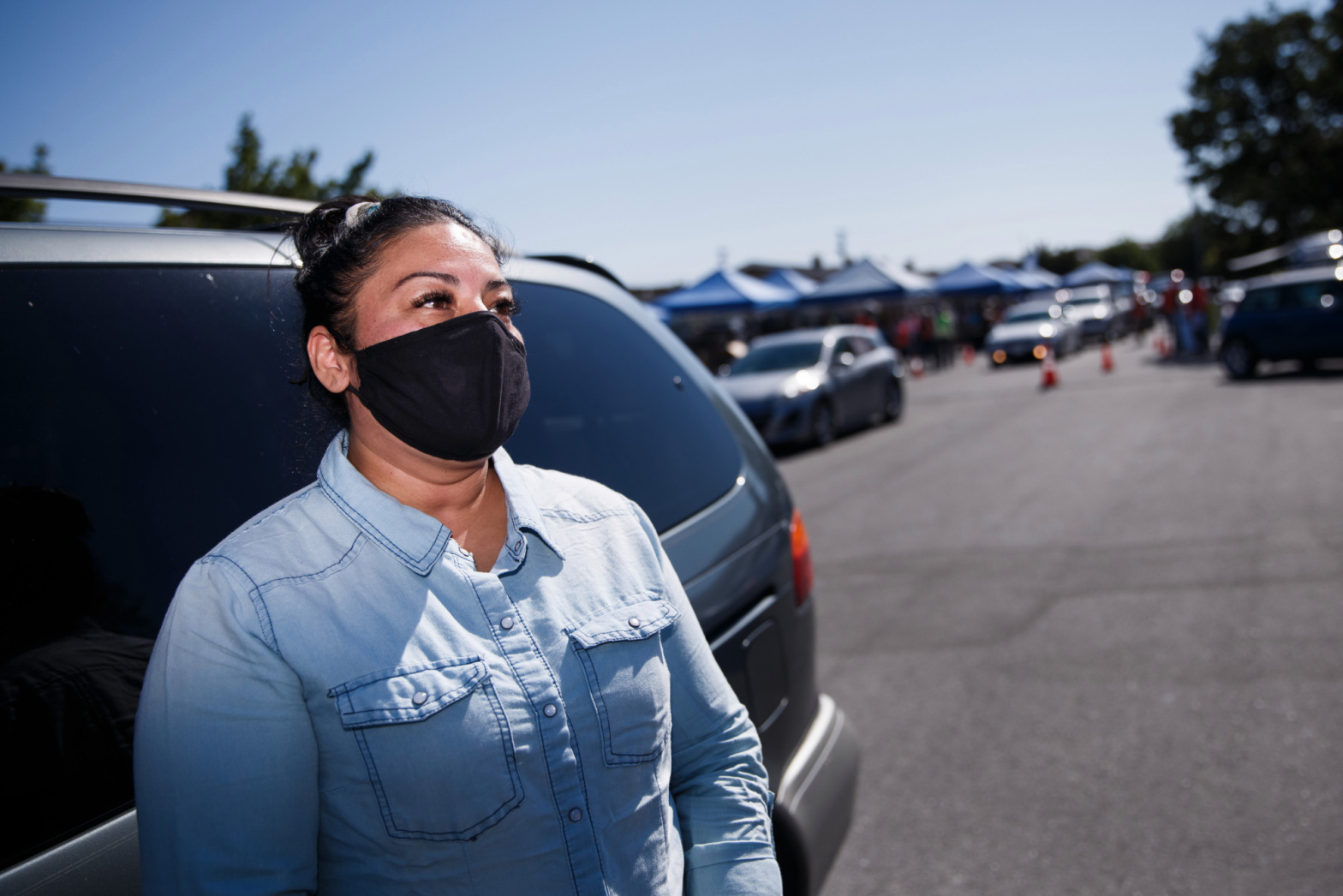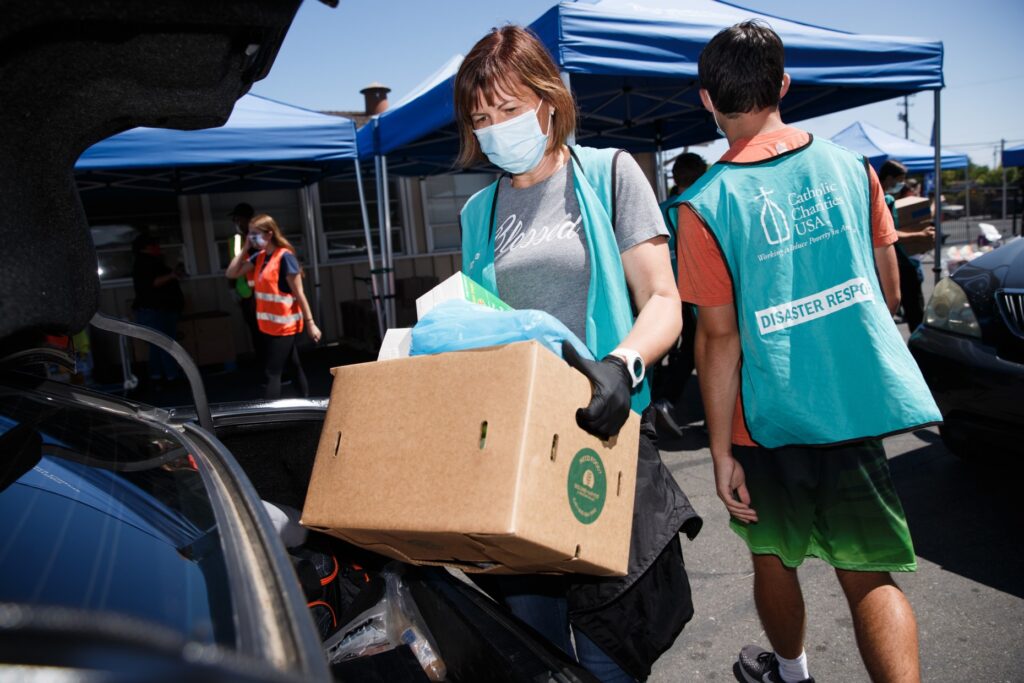‘I was looking at a nightmare:’ Spanish-speakers hard hit by COVID relied on food banks instead of government assistance

Everything came crashing down on Carmen Magallanes when the COVID-19 pandemic shut down schools.
She lost her job at a company that prepared meals for schools, and her two older daughters who were attending universities moved back in with her and her 7-year-old son.
“It was difficult because the only cash income was from me because my kids don’t work. They were studying,” Magallanes said in Spanish. “Suddenly I was looking at a nightmare because the savings I had were diminishing.”
The single mother worried she wouldn’t be able to pay the rent and would have to move back to Mexico, jeopardizing her children’s educational opportunities.
Spanish-speaking Latinos were among the hardest hit during the COVID-19 pandemic, reporting some of the highest levels of food insecurity driven by a wave of job losses, according to data from the U.S. Census Bureau. Despite that, they were just as likely as their English-speaking Latino counterparts to seek food assistance, relying on food banks, church groups and other charities for food and essentials. But experts say that because of their higher levels of food insecurity, that leaves Spanish speakers at higher risk for hunger and falling through their ad hoc safety net.
Only Magallanes’ son was young enough to be eligible for government food assistance, so on a recent Friday, she drove to St. Lucy’s Parish in Campbell for a food bank run by Catholic Charities of Santa Clara County and supported by Second Harvest of Silicon Valley. Volunteers helped load cars with boxes full of canned food and produce, as well as oatmeal, milk, pasta and more. The donations have helped Magallanes navigate the financial crisis so she and her family could stay in their San Jose home.
Magallanes’ experience during the pandemic is not unusual, experts said, driven in part by Spanish-speakers’ limited job prospects that leave them more exposed to economic downturns.
“English-speaking, U.S.-born residents of California are more likely to have a middle-class job,” said Lucas Zucker, policy and communications director of the nonprofit CAUSE. “If you are a monolingual Spanish-speaker, you simply have (fewer) job opportunities and are pushed to the worst paid jobs on the labor market, and then those are the folks who get hit hardest by job losses.”
The data bears that out: Latinos who responded to a census bureau survey on employment in Spanish were 50 percent more likely to say they or someone in their household had lost work compared to Latinos who responded to the survey in English. Those Spanish-speaking workers often have fewer savings to fall back on, said Zucker, whose Central Coast nonprofit advocates for policy changes aimed at low-income and immigrant workers.

Fewer job prospects and savings leave those families exposed to hunger. About 10 percent of Latinos across the U.S. who responded to the census bureau survey in English said they were food insecure in late March, double the rate of White respondents. But among Latinos who responded in Spanish, more than 20 percent said they were food insecure.
América Gomez, managing director of Catholic Charities’ CORAL program, has seen that first hand. Her roughly 100 employees, who usually provide after-school academic help, switched to distributing food during the pandemic. Many are college students whose families were going through the same crisis as the food bank’s clients.
“I couldn’t tell you how many people told me, ‘América, I’m the only person working in my family, my mom got laid off, my dad got laid off,’” Gomez said.
But despite their higher food insecurity, Latinos who responded to the census bureau in Spanish and English were equally likely to receive food stamps — managed in California by CalFresh. Standing in Spanish speakers’ way, experts said, were concerns about immigration status, confusing eligibility rules that can stymie even English speakers and overwhelmed government caseworkers.
Among the biggest barriers, Gomez said, was fear stoked by the Trump administration’s anti-immigrant rhetoric. Particularly troubling for many immigrants was the now-repealed public charge rule imposed by former President Donald Trump, which made immigrants receiving food stamps and other noncash benefits ineligible for visas or permanent residency.
“With the Trump administration there was so much negative media (attention), it was scaring a lot of our community,” Gomez said. “And a lot of them had the right to be scared, with everything going on.”
Experts said it will take years and concerted effort to rebuild trust between government and immigrants after the public charge rule. In the meantime, many Latinos have turned to an imperfect solution, relying on community organizations they already know, said Leslie Bacho, CEO of Second Harvest Silicon Valley.
“The best way for people to get food assistance is through CalFresh because just like you and me, everybody would like to go to the grocery store and select the items that they want,” Bacho said, adding that many clients turn to selling personal goods, starting small businesses and taking on multiple jobs before going to her organization for help.
For Magallanes and her family, things have slowly been getting back to normal. She’s still visiting the food bank to help cover expenses but her job, which returned on a part-time basis in October, recently moved back to full-time. In the meantime, she’s been telling people she knows that it’s safe to visit food distribution sites like the one she visited.
“A lot of us, we don’t dare go to those places,” she said. “I share (that information) with my community.”

